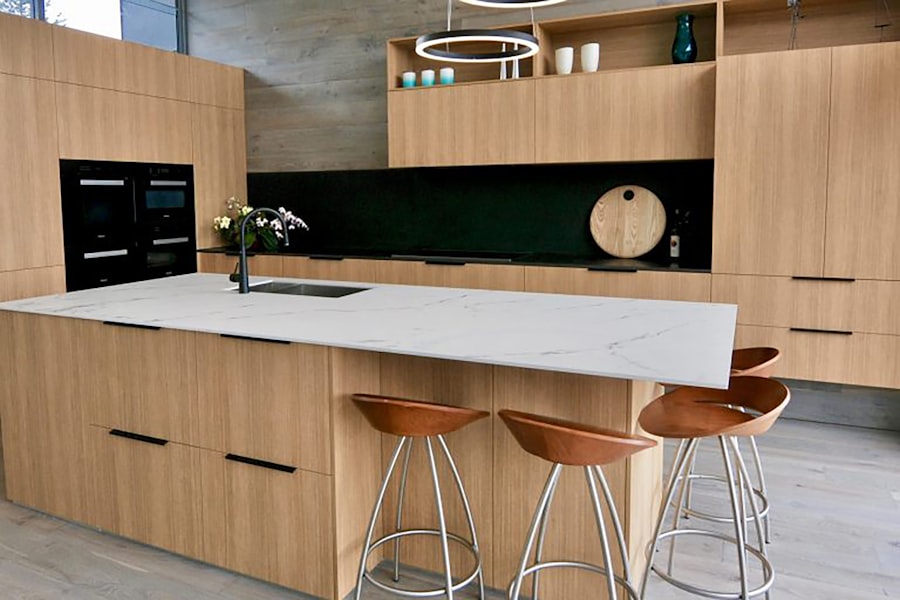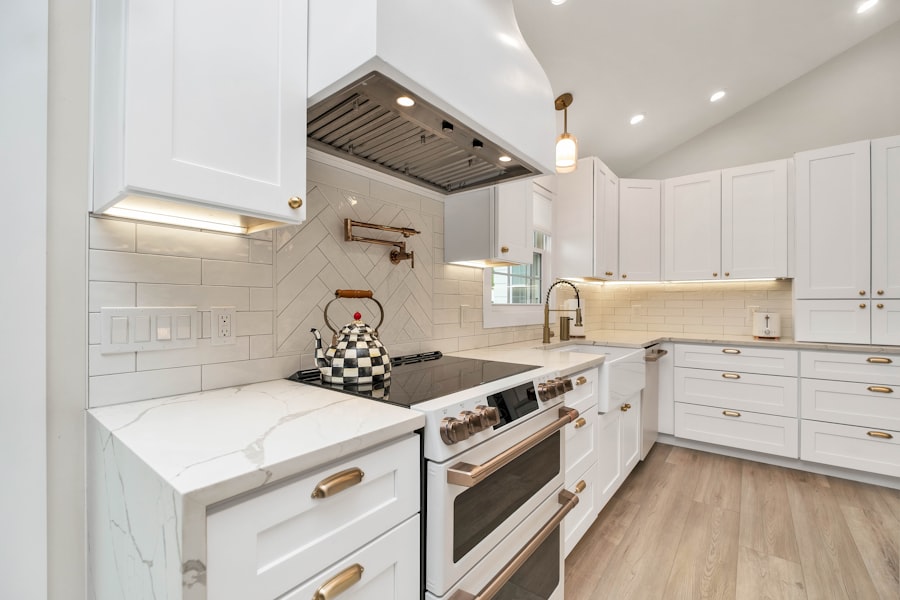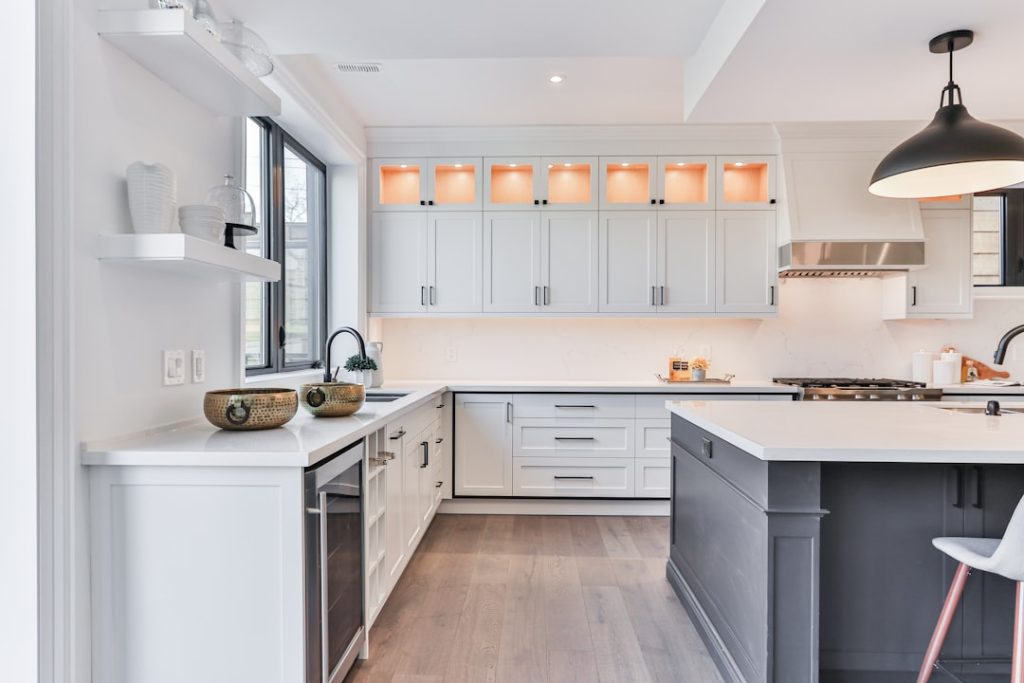Custom cabinets offer a myriad of advantages that can significantly enhance both the functionality and aesthetic appeal of a space, particularly in kitchens and bathrooms. One of the most compelling benefits is the ability to tailor the cabinets to fit the specific dimensions and layout of a room. Unlike pre-fabricated options, which often come in standard sizes that may not suit every space, custom cabinets can be designed to maximize every inch of available area.
This is especially beneficial in homes with unique architectural features or unconventional layouts, where standard cabinetry might leave awkward gaps or fail to utilize space effectively. Moreover, custom cabinets allow homeowners to express their personal style and preferences. With a vast array of materials, finishes, and hardware options available, individuals can create a look that aligns perfectly with their vision for their home.
Whether one prefers a sleek, modern aesthetic or a more traditional, rustic feel, custom cabinetry can be designed to reflect that vision. This level of personalization not only enhances the beauty of a space but also contributes to a sense of ownership and satisfaction in one’s home environment.
Key Takeaways
- Custom cabinets enhance kitchen functionality and aesthetics tailored to your needs.
- Selecting the right style and materials ensures durability and complements your kitchen design.
- Maximizing storage with customized features improves organization and usability.
- Collaborating with professionals guarantees precise design and quality installation.
- Proper budgeting and regular maintenance extend the lifespan of your custom cabinets.
Choosing the Right Style and Design for Your Kitchen
When it comes to selecting the right style and design for custom cabinets, it is essential to consider both functionality and aesthetics. The kitchen is often regarded as the heart of the home, serving as a gathering place for family and friends. Therefore, the design should not only be visually appealing but also conducive to cooking and entertaining.
Popular styles range from contemporary and minimalist designs featuring clean lines and neutral colors to more ornate traditional styles with intricate moldings and rich wood finishes. Each style has its own unique characteristics that can dramatically influence the overall ambiance of the kitchen. In addition to style, the layout of the kitchen plays a crucial role in determining cabinet design.
For instance, an open-concept kitchen may benefit from cabinetry that seamlessly integrates with adjacent living spaces, creating a cohesive flow throughout the home. On the other hand, a more enclosed kitchen might allow for bolder design choices that stand out as focal points. It is also important to consider how the cabinet design will interact with other elements in the kitchen, such as countertops, backsplashes, and appliances.
A well-thought-out design will ensure that all components work harmoniously together, enhancing both functionality and visual appeal.
Maximizing Storage and Functionality with Custom Cabinets

One of the primary reasons homeowners opt for custom cabinets is the opportunity to maximize storage and functionality. In many kitchens, space can be at a premium, making it essential to utilize every available area efficiently. Custom cabinetry can be designed with various storage solutions tailored to individual needs.
For example, incorporating pull-out shelves, lazy Susans, or deep drawers can make accessing pots, pans, and pantry items much easier than traditional shelving methods. These features not only improve organization but also enhance the overall usability of the kitchen. Additionally, custom cabinets can be designed to accommodate specific appliances or tools that may not fit standard cabinetry.
For instance, if a homeowner has a large stand mixer or specialty cookware, custom cabinets can include dedicated spaces for these items, ensuring they are easily accessible yet neatly stored away when not in use. Furthermore, integrating features such as built-in spice racks or wine storage can elevate both the functionality and aesthetic appeal of the kitchen. By focusing on maximizing storage solutions through thoughtful design, custom cabinets can transform a cluttered kitchen into an organized and efficient workspace.
Customizing Features and Add-ons for Your Cabinets
| Feature/Add-on | Description | Customization Options | Typical Installation Time | Impact on Storage Capacity |
|---|---|---|---|---|
| Soft-Close Hinges | Hinges that close doors quietly and smoothly | Material finish, tension adjustment | 1-2 hours per cabinet | None |
| Pull-Out Shelves | Shelves that slide out for easier access | Size, weight capacity, number of shelves | 2-4 hours per cabinet | Increases usable space by 10-15% |
| Built-in Lighting | LED lights installed inside cabinets | Light color, brightness, sensor options | 3-5 hours per cabinet | None |
| Custom Inserts | Dividers and organizers for utensils and tools | Material, layout, size | 1-3 hours per drawer | Improves organization, no change in capacity |
| Glass Doors | Cabinet doors with glass panels | Glass type, frame style, tint | 4-6 hours per cabinet | None |
| Lazy Susan | Rotating shelves for corner cabinets | Diameter, number of tiers | 3-4 hours per cabinet | Increases accessibility, no net capacity change |
| Under-Cabinet Hooks | Hooks installed beneath cabinets for hanging items | Hook style, number of hooks | 0.5-1 hour per cabinet | None |
The beauty of custom cabinets lies not only in their design but also in the myriad of features and add-ons that can be incorporated to enhance their functionality. Homeowners have the opportunity to customize their cabinets with various innovative features that cater to their specific needs and lifestyle. For example, soft-close hinges and drawer slides are popular upgrades that provide a quiet and gentle closing mechanism, preventing slamming and wear over time.
This small addition can significantly improve the user experience in daily kitchen activities. Another popular customization option is the inclusion of specialized compartments for utensils or cutting boards. These features can streamline cooking processes by keeping essential tools within easy reach while maintaining an organized appearance.
Additionally, lighting options such as under-cabinet LED strips can illuminate workspaces effectively while adding an elegant touch to the overall design. Such enhancements not only improve functionality but also contribute to creating an inviting atmosphere in the kitchen.
Selecting the Best Materials for Your Custom Cabinets
Choosing the right materials for custom cabinets is crucial in achieving both durability and aesthetic appeal. The material selection process involves considering factors such as style preferences, budget constraints, and intended use. Solid wood remains a popular choice due to its timeless beauty and strength; however, it can be more expensive than other options.
Different types of wood offer varying characteristics; for instance, oak is known for its durability and grain patterns, while maple provides a smoother finish that can be ideal for modern designs. In addition to solid wood, engineered materials such as plywood or MDF (medium-density fiberboard) are often used in custom cabinetry due to their cost-effectiveness and versatility. These materials can be finished with veneers or laminates to achieve a desired look while maintaining structural integrity.
It is also essential to consider finishes when selecting materials; high-quality paints or stains can enhance the appearance of cabinetry while providing protection against wear and tear. Ultimately, selecting materials that align with both aesthetic desires and practical needs will ensure that custom cabinets stand the test of time.
Working with a Professional to Design and Install Your Custom Cabinets

Collaborating with a professional designer or cabinet maker is an invaluable step in creating custom cabinets that meet your specific needs and preferences. Professionals bring expertise in design principles, material selection, and installation techniques that can elevate the quality of your cabinetry project. They can help translate your vision into a functional design while offering insights into current trends and best practices in cabinetry.
During the design process, professionals will often conduct an in-depth consultation to understand your lifestyle requirements and aesthetic preferences. This collaborative approach ensures that every detail is considered, from layout and style to storage solutions and finishes. Once the design is finalized, skilled craftsmen will handle the fabrication and installation of your custom cabinets, ensuring precision and quality throughout the process.
Their experience minimizes potential pitfalls during installation, resulting in a seamless integration of cabinetry into your space.
Budgeting and Financing Your Custom Cabinet Upgrade
Upgrading to custom cabinets is an investment that requires careful budgeting and financial planning. The cost of custom cabinetry can vary widely based on factors such as materials used, complexity of design, size of the project, and labor costs associated with installation. It is essential to establish a realistic budget early in the planning process to avoid overspending or compromising on quality.
Homeowners should consider exploring various financing options if upfront costs are prohibitive. Many cabinet makers offer financing plans that allow for manageable monthly payments over time. Additionally, some homeowners may choose to allocate funds from home equity loans or lines of credit specifically for home improvement projects like cabinetry upgrades.
It is crucial to weigh these options carefully against long-term financial goals while ensuring that any financing chosen aligns with your overall budgetary constraints.
Maintaining and Caring for Your Custom Cabinets for Longevity
To ensure that custom cabinets remain beautiful and functional for years to come, proper maintenance and care are essential. Regular cleaning is one of the simplest yet most effective ways to preserve cabinetry; using gentle cleaners specifically designed for wood or laminate surfaces helps prevent damage from harsh chemicals or abrasive materials. Wiping down surfaces with a soft cloth regularly will help remove dust and grime without scratching finishes.
In addition to routine cleaning, it is important to address any minor repairs promptly to prevent further damage. For instance, if a drawer begins to stick or a hinge becomes loose, addressing these issues early on can prolong the life of your cabinets significantly. Furthermore, applying protective coatings or sealants periodically can help maintain finishes against wear from daily use.
By investing time in maintenance practices, homeowners can enjoy their custom cabinets’ beauty and functionality for many years ahead.



